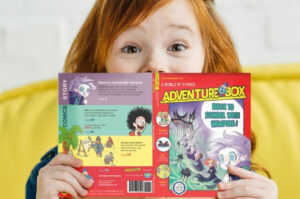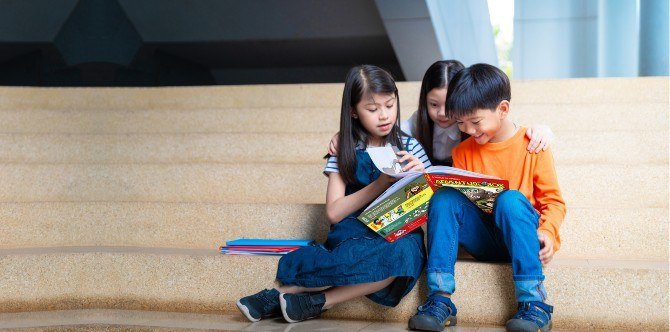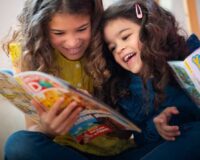Kids can come up with the most uncomfortable questions at the most unpredictable moment. Questions like,Where do babies come from? and How many stars are there in the sky? orCan we meet grandma in heaven? and Why did you send my hamster to the farm?
While some questions have direct answers, some might put you in an awkward position; especially if the topics revolve around death, loss, grief, anger, and jealousy among other things.
But what if someone explained these topics to kids in a language that they understand? Well, that’s where educational children magazines come into play.
How Children Magazines Can Solve The Mystery Called ” Life”

Such magazines imbibe real-world topics within their stories that help children comprehend complex human emotions like grief, loss, suspense, sadness, anger, jealousy and more. And leading the charge to fulfil this mission is Thuy-Ngan Pham, Deputy General Manager at Bayard Presse Asia.
Founded in 1870, the 150-year-old French company is one of the largest publishers of educational children’s magazines. Their aim is to help young kids discover the world through special stories curated for their growing minds.
Educational Children Magazine: The Box Collection
And for this, the publication has introduced its new Box Collection of educational childrenmagazine. This includes the StoryBox for ages 3-8 years, AdventureBox for ages 6-10 years, AdventureBox Max! for ages 9-14 years and DiscoveryBox for ages 7-14 years.
Children get to read engaging content thateasy on the mind and offers an insight into the core values about life, broadening their horizon.
Everything in the magazine starts with the children and the family in mind, says, Thuy-Ngan told theAsianparent.It is not rare that a story comes directly from a reader’s question, a parent’s concern. We create stories that touch children and make them want to reflect on it because they can see themselves in our stories through the main characters.
For instance, the magazine introduced characters that suffered from lesser-known conditions such as that impairs writing ability and fine motor skills. The publication incorporated these in their AdventureBox magazine that caters to kids between the ages of 6-10 years.
We have a team of writers and illustrators who are passionate about nurturing young minds and hearts, but at the end of the day, we work closely with children and specialists. Before the story is published, the writers go into schools, meet their readers, test their ideas, adds Thuy-Ngan.
Is this sentence making sense? Do the children laugh? Are they mesmerised? Our magazines grow with the children and we help them grow because of our close relationship with them, she says.
Adding,We also consult specialists and speech therapists to make sure the right words are used, and that the phrasing is correctly understood, while psychologists’ advice ensures that the stories are relevant and age-adapted.
Opening Room For Dialogue With Stories

The publishers choose topics that present an opportunity for open discussions. They ask questions that sometimes may not have a straight answer.
Thuy-Ngan explains,The story and the characters are all indirect media that allow and facilitate dialogue and reflection. Some of our stories are fun and happy, while some talk about deeper subjects that show how the hero deals with complicated situations. We make sure that the stories are adapted to the age of our audience, but they are as varied as life itself.
She also highlights that its stories aren’t the run-of-the-mill fairytales that most kids grow up with. No sir! No prince charming arrives to save the damsel in distress. Instead, the damsel musters the courage in these stories to defend herself and also save the prince on occasion.
We foster creativity and imagination, but our heroes, like our children, are unpredictable and full of surprises! she adds.
Improving Literacy In Kids. Educational children magazine also help enable a better literacy quotient in children beyond the academic reading materials.
As Thuy-Ngan explains,A young child who can retell a story with his or her own words and explain what was moving in the story is one step closer to literacy. It is the passion that fosters literacy in the long term. And passion also comes from enjoyment.
This is why childrenmagazines are rich in stories that hook them into reading, help them grow their confidence, but have comics and games to keep it fun! adds Thuy-Ngan.
Besides, many of our stories focus on empathy and diversity. At heart, we wish to foster soft skills and creativity, help kids understand different points of view and be more open-minded and versatile. Academic reading material doesn’t necessarily have these in mind, she explains.
Nothing Like The Flutter Of Pages Over An E-Book
In todayage where screen time is exorbitant and learning is completely virtual, can physical magazines compete against e-books?
Thuy-Ngan seems to think there is nothing to replace the joy and comfort of reading a softbound book.
Ebooks can be a complement but nothing can replace the tactile experience of a magazine, she says. Adding,The paper we use and the size of our magazines are adapted to the children’s age, turning them into an everyday friend that they can easily travel with everywhere and kept handy.
It’s a physical object that they can mark up, colour in, dog ear, cut out, or add things onto, at their own pace, she says.
Any book lover worth their salt will tell you this, the joy of smelling a new book remains unparalleled that no expensive tablet or e-book reader can match. The rustling of pages as they rub against each other just hits different.
There is the mystery of discovering what’s on the next page, along with the novelty of turning the page itself, that an ebook click cannot replicate. And of course, the feeling of ownership of a paper magazine is also very powerful, adds Thuy-Ngan.
Many of our readers are so proud to show off their physical libraries, and some would never miss an issue to make sure to have a complete collection, she says.
More To Time To Read During The Pandemic

Thuy-Ngan also revealed their research found that kids had more opportunities to read during the Covid-19 pandemic.
Additionally, it has had the unintentional effect of also enabling parents to have more time to spend with their children. The unexpected luxury has reminded many parents how time is precious and how important it is to make the most of little moments with our loved ones — especially since they are growing so fast! she says.
But itnot just the educational childrenmagazine that remains the gold standard for children. Digital media has also been a significant contributor towards the growth by offering more variety and purchase convenience. Added features like audiobooks have also made story time more interactive and exciting, says Thuy-Ngan.However, it is worth noting that some parents, especially those of infants and toddlers, are reluctant to be turning their child onto screen time so early.
There will always be something special about paper that digital screens will never capture, she signs off.
See the original post: https://sg.theasianparent.com/educational-childrens-magazine









